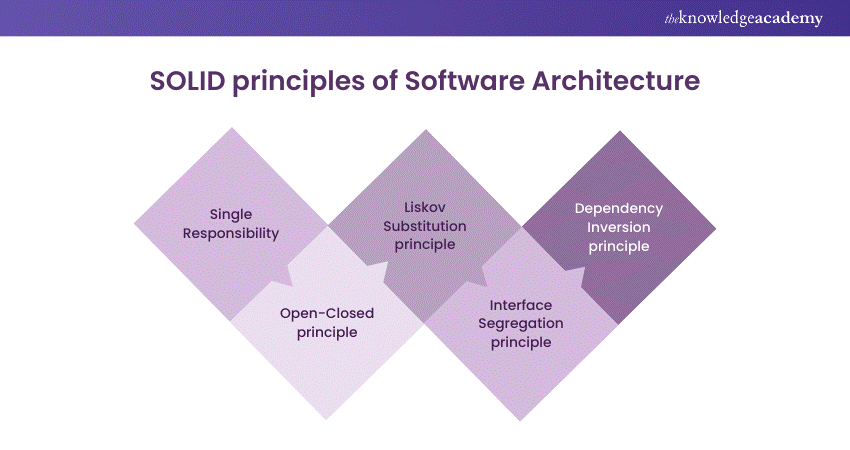We may not have the course you’re looking for. If you enquire or give us a call on 01344203999 and speak to our training experts, we may still be able to help with your training requirements.
Training Outcomes Within Your Budget!
We ensure quality, budget-alignment, and timely delivery by our expert instructors.

For developing an innovative and eminent software that seamlessly solves problems for end users, a strong foundation is necessary. In the software league, the term ‘software’ holds great importance. It's by far the most crucial part of the system. This brings us to the question - What is Software Architecture?
To begin with, Software Architecture is a huge part of our daily lives. Starting from scrolling through smartphones to receiving crucial mail, it is all dependent on this architecture. Every small or big task on applications that look simple to the users is dependent on a complex architecture.
The overall abstraction that makes the software product very user-friendly is the ulterior motive of good software. To learn more about how applications can be enhanced, read this blog. In this blog, you will learn everything about Software Architecture, all its different components, importance and drawbacks.
Table of Contents
1) What is Software Architecture?
2) Objectives of Software Architecture
3) SOLID principles of Software Architecture
4) Importance of Software Architecture
5) Drawbacks of Software Architecture
6) Conclusion
What is Software Architecture?
Software Architecture refers to the skeleton of the software system, the optimal level of framework. It significantly impacts the quality of code, workflow, and level of ease for development and deployment. You can think of it as a bunch of fundamental compounds bound together to form the bedrock of the Software system.
Software Architecture is primarily based on a set of most important decisions for Software Development. Each of these decisions impacts the overall success and performance of the final product. These decisions comprise the following:
1) Selecting structural components and their interfaces
2) Behavioural traits during collaboration between the chosen components
3) Composition of the components in the large subsystem
4) Architectural alignment with business objectives
Software Architecture is often referred to as the blueprint of an actual system. It includes different contributory factors – design, IT environment, human dynamics, quality attributes, and business strategy. Architecture is responsible for all nonfunctional decisions cast and separated by the functional requirements.
Many believe that software design and architecture are different; however, fundamentally, they are the same. Software design is one of the initial phases of the Software Development Cycle (SDLC).
Software Architecture is the plan that constrains Software system design to avoid mistakes. It helps achieve technological and business strategies. To sum it up, “how” the Software gets built is Software design, and “what” is being built is Software Architecture.
Objectives of Software Architecture
The primary objective of Software Architecture is to identify requirements that affect the application's structure. A well-built Architecture reduces business risks associated with building technical solutions. It acts as a bridge between technical and business requirements. The other objectives include the following:
1) Exposing the structure of the Software system
2) Keeping the structure’s implementation details under cover
3) Register all use-cases and scenarios
4) To select quality attributes to be optimised for the system
5) Reduces development costs
6) Improve product’s market position
7) Improve quality and productivity offered by the system
Discover all the essentials of Software Engineering with our Softwrae Engineering Course - join today!
SOLID principles of Software Architecture
Single Responsibility, Open-Closed, Liskov Substitution, Interface Segregation, Dependency Inversion, or simply – SOLID is a set of popular principles used in object-oriented Software Development. SOLID is an acronym for the five key architectural principles. It is followed to avoid mistakes during the formulation of product strategy. A Software Architecture must adhere to these principles in order to avoid any developmental failure:

Single Responsibility
The Single Responsibility principle is technical. It states that a class should have one and only one reason to change, meaning that a class should have only one job. To simplify, only one change in the software identification should affect the class specification of the data container (class), as many different teams work on the same project and edit it for different reasons, making the modules incompatible. Thus, Single Responsibility is important because it makes version control easier.
Open-Closed principle
The Open-Closed principle states that objects or entities should be open for extension but closed for modification. Here, modification refers to changing the code of an existing data container. This principle describes that you can add new functionality without altering any of the existing code.
Liskov Substitution principle
Liskov's Substitution principle states that subclasses should be substitutable for their base class. This means independent services, or subclass, should be able to substitute the base or parent class.
Interface Segregation principle
As the name suggests, Interface Segregation is about separating the interfaces. This principle states that several client specific interfaces are better than one general purpose interface. It means that software should be divided into microservices and there should not be any redundancies.
Dependency Inversion principle
The Dependency Inversion principle states that classes should depend on interfaces instead of concrete classes and functions. Higher level modules should not be dependent on low or lower-level modules and similarly change in the higher level should not have effect on the lower level.
Enhance your tech skills with our Programming and DevOps Courses - get enlisted now!
Importance of Software Architecture
Software Architecture falls under the design phase of the SDLC, one of the initial stages of the Software Development process. Without Software Architecture, the development process is close to zero. Being one of the most important parts of SDLC, from technical and developmental point of view, the following reasons are why Software Architecture is of great importance:
1) Responsible for selecting quality attributes to optimise a system
2) Expedite early prompt
3) A clear platform to build on
4) Streamlining code
5) Faster product launch
6) Additional security checks and risk management
Drawbacks of Software Architecture
With all its glory, Software Architecture is still an emerging discipline within the domain of Software Engineering. Hence, it also comes with the following drawbacks:
1) It is not suitable for interactive applications after output is obtained after a series of transformation
2) Components, if not designed independently, it might lead to tight data coupling
3) Extra tools or filters might be needed to make independent components compatible with each other
4) Lack of understanding of the design process, experience and evaluation
5) Methods are not suitable for analysis to predict if the implementation of the architecture meets the requirement
Conclusion
In conclusion, Software Architecture is the fundamental of an effective Software framework that maintains quality of the product. It is responsible for making user interface easy and management effortless. It is both time saving and cost effective if practiced properly and with proper knowledge.
Heighten your software tech knowledge through our Software Design and Architecture Course.
Frequently Asked Questions

There are various types of architectural patterns in Software Architecture. Each serves a different approach. Some common types include Pipe-Filter, Component-based, Client-server and Microkernel.

Software Architecture exposes the structure of a system while keeping implementation details undercover. It also helps in the interaction of components and elements. It also delves into the system's implementation details.

The Knowledge Academy takes global learning to new heights, offering over 30,000 online courses across 490+ locations in 220 countries. This expansive reach ensures accessibility and convenience for learners worldwide.
Alongside our diverse Online Course Catalogue, encompassing 17 major categories, we go the extra mile by providing a plethora of free educational Online Resources like News updates, Blogs, videos, webinars, and interview questions. Tailoring learning experiences further, professionals can maximise value with customisable Course Bundles of TKA.

The Knowledge Academy’s Knowledge Pass, a prepaid voucher, adds another layer of flexibility, allowing course bookings over a 12-month period. Join us on a journey where education knows no bounds.

The Knowledge Academy offers various Programming and DevOps courses, including Software Engineering courses, App and Web Development training, and Framework Training courses. These courses cater to different skill levels, providing comprehensive insights into How to Make a Website?
Our Programming and DevOps blogs cover a range of topics related to Software Architecture, offering valuable resources, best practices, and industry insights. Whether you are a beginner or looking to advance your Software Architecture skills, The Knowledge Academy's diverse courses and informative blogs have you covered.
Upcoming Programming & DevOps Resources Batches & Dates
Date
 Software Design and Architecture Training
Software Design and Architecture Training
Fri 5th Jul 2024
Fri 4th Oct 2024







 Top Rated Course
Top Rated Course



 If you wish to make any changes to your course, please
If you wish to make any changes to your course, please


